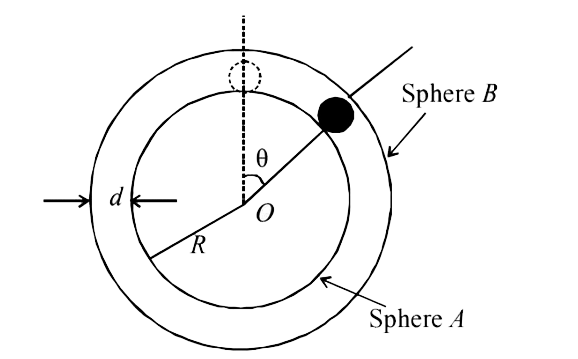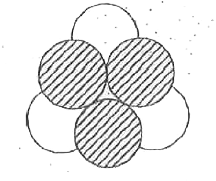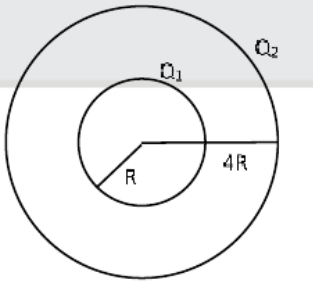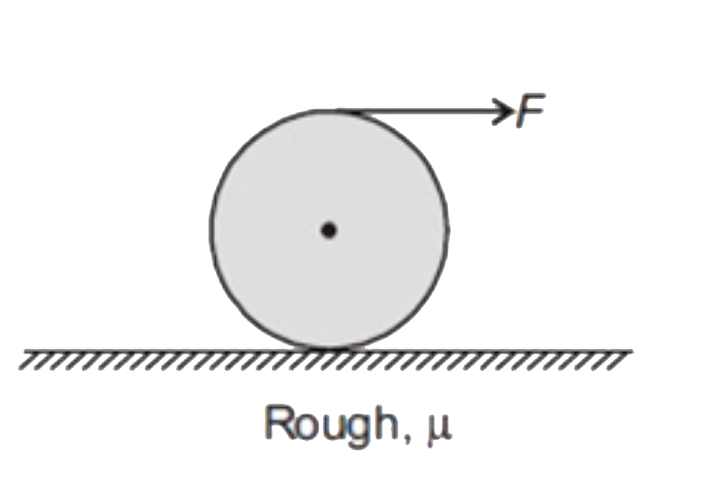A sphercial ball of mass m is kept at the highest point in the space between two fixed, concentric spheres A and B (figure). The small sphere A has a radius R, and the space between the two spheres has a width d. The ball has a diameter very slightly less than d. All surfaces are frictionless. The ball is given a gentle push (towards the right figure). The angle made by the radius vector of the ball with the upward vertical is denoted by (shown in figure).

a. Express the total normal reaction force exerted by the sphere on the ball as a function of angle .
b. Let and denote the magnitudes of the normal reaction forces on the ball exerted by spheres A and B, respectively. Sketch the variations of and as functions of in the range by drawing two separate graphs in your answer book, taking on the horizontal axes.
The correct Answer is:2,0
The ball is moving in a circular motion. The necessary centripetal force is provided by .
Therefore
According to mechanical energy conservation
From (i) and (ii)

The above equation shows that as increases decreases. At a particular value of . will become zero and the ball will lose contact with sphere A. This condition can be found by putting NA = 0 in eq. (III)
The graph between
From eq. (iii) when .
When
The graph is a straight line as shown.
When

From (iv) and (v) we get
When
When . Therefore the graph is as shown.

Topper's Solved these Questions
- BOOK - VMC MODULES ENGLISHCHAPTER - ENERGY & MOMENTUMEXERCISE - JEE ADVANCE (ARCHIVE) - PARAGRAPH QUESTIONS5videos
ENERGY & MOMENTUM
- BOOK - VMC MODULES ENGLISHCHAPTER - ENERGY & MOMENTUMEXERCISE - JEE ADVANCE (ARCHIVE) - ASSERTION & REASON TYPE1videos
ENERGY & MOMENTUM
- BOOK - VMC MODULES ENGLISHCHAPTER - ENERGY & MOMENTUMEXERCISE - JEE MAIN (ARCHIVE)53videos
ENERGY & MOMENTUM
- BOOK - VMC MODULES ENGLISHCHAPTER - ELECTROSTATICSEXERCISE - JEE Advanced (Archive)89videos
ELECTROSTATICS
- BOOK - VMC MODULES ENGLISHCHAPTER - GASEOUS STATE & THERMODYNAMICSEXERCISE - JEE ADVANCED (ARCHIVE )111videos
GASEOUS STATE & THERMODYNAMICS
Similar Questions
A spherical balll of mass m is the highest point in the space between two fixed , concentic sphere A and B the smaller the two sphere A has a radius R and the space between the two spheres has a width d . The bell has a disneter very dightly less then d . All surface are frictionless . The bell is a given a gentle push (owards the right in the figure ) The upward vertical is denoted by θ (shown ijn the figure)

(a)Express the total normal reaction force exerted by the sphore on the as a finction of angle θ
(b) Let N_(A)andNBdenote in the magnitubes of the normal reaction force on the bell evered by the sphare A and B repectively Skech the variation of NAandN_(B)asfunctionsofcos theta ∈theran≥0 le theta le pi bydraw∈gtwoseparategraph∈youranswerb∞ktak∈gcos theta an the horizental axas.View SolutionA small spherical ball of mass m is projected from lowest point (point P) in the space between two fixed, concentric spheres A and B (see figure). The smaller sphere A has a radius R and the space between the two spheres has a width d. The ball has a diameter very slightly less than d. All surfaces are frictionless. Speed of ball at lowest point is v. NA and NB represent magnitudes of the normal reaction force on the ball exerted by the spheres A and B respectively. Match the value of v given in column–I with corresponding results in column–II.
 View Solution
View SolutionThe empty space between the shaded balls and hollow balls as shown in the diagram is called
 View Solution
View SolutionA sphere with diameter 10 meters is inscribed in a cube .What is the volume of the space between the sphere and the cube ?
View SolutionA sphere of mass m held at a height 2R between a wedge of same m and a rigid wall, is released from, Assuming that all the surfaces are frictionless. Find the speed of the bodies when the sphere hits the ground.
 .View Solution
.View SolutionIn the given figure there are two concentric shells find potential difference between spheres.
 View Solution
View SolutionA solid sphere of mass M and radius R is pulled by a force F as shown in figure . If the sphere does not slip over the surface , then frictional force acting on the sphere is
 View Solution
View SolutionA sphercial ball of mass 5kg is resting on a plane with angle of inclination 30∘ with respect to the horizontal as shown in the figure. The ball is held in place by a rope attached horizontally to the top of the ball and to the slope. The frictional force acting on the ball is
 View Solution
View SolutionA solid metal sphere of radius R has a charg +2Q. A hollow spherical shell of radius 3R placed concentric with the frist sphere has net charge -Q.

What would be the final distribution of charges if the sphres are joined by a conducting wireView SolutionA sphere of mass M rolls without slipping on rough surface with centre of mass has constant speed v0. If mass of the sphere is m and its radius be R, then the angular momentum of the sphere about the point of contact is.
View Solution

